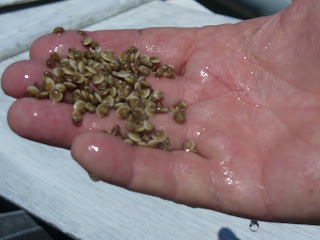
I can not imagine there are many advantages to living in hurricane-prone areas. I mean, I can imagine many advantages to the areas themselves -- living near a beach, gorgeous weather deep into the year, having swimsuits qualify as "casual wear -- but from June to November of each year, I can't think that hurricanes rank too high on everyone's Things I Love About the South list. To further reinforce that assertion, I need only ask Chef Tim Lyons at blu seafood and bar. After all, it was Hurricane Wilma that chased him from his plush digs in the Keys and Louie's Backyard and sent him and his coastal cuisine to Durham. (Thanks, Wilma!) But if one had to look for a silver lining behind that dark funnel cloud, I would imagine that the Southern tradition of the Hurricane Party would have to qualify.
Folks in coastal towns all across the Southeast and the Gulf are familiar with the tradition of the Hurricane Party. These get-togethers need very few requirements in order to manifest. First, you need a safe location, preferably a structure that can stand high winds and high waters. Second, you need a lot of food and some adult drinks. Third, and most important, you need a hurricane.
The Hurricane Party serves many purposes. Since they can sometimes last as long as 3-5 days, they help provide a welcome destraction from the potential destruction that is going on just outside the walls of the "safehouse." Friends and neighbors all gather together to wait out the storm and use all different sorts of diversions, be it board games, drinking games, or anything else that might help pass the time. The sense of community comforts many people and alleviates the stress of a potentially disturbing situation.
Hurricanes typically knock out the power in many of these regions, which illustrates another vital function of the Hurricane Party. Many households, restaurants and other businesses have caches of foodstuffs that could rot or spoil without proper refrigeration and, once the power goes out, this process is expedited. So these huge gatherings help people consume their refrigerated and frozen goods rather than see them wasted. Often times, food that goes bad quicker is consumed at the earlier hours of the hurricane party, which leads to the ice cream going first!
In typical Keys tradition, Chef Tim Lyons and the staff at blu will be hosting our Second Annual Hurricane Party this Thursday, September 2nd. Don't worry about the hurricane; you don't need one at blu to enjoy this party! Instead, we will take a smoker and a grill out back and prepare cuisine inspired by Hurricane-prone regions. Gumbo from New Orleans, Cuban roast pork, Jamaican Smoked Jerk Chicken, to name a few. And what Hurricane Party would be complete without beverages? How about some mojitos, daquiris, Alabama slammers and... er, hurricanes?
$25 is all it will cost for the food. We'll set up serving stations outside, get some cool reggae and zydeco tunes, and have a cool relaxing evening with some good food and friends. Also, be sure to check out our new mural provided by Sneha, Lynette and Amy, three wonderful Jordan High School Art Department alumnus. The weather should be turning cooler and I predict an awesome evening.
Reserve now!













